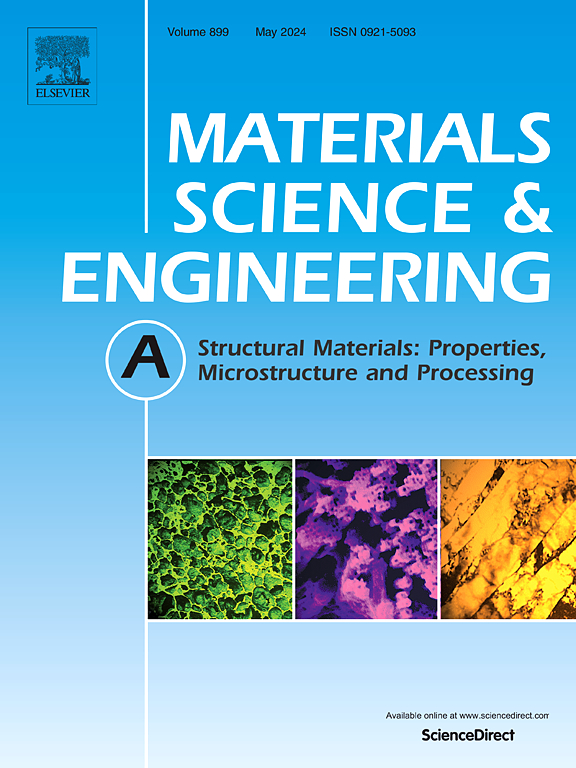退火温度对自定义465马氏体时效不锈钢冷轧组织和力学性能的影响
IF 7
2区 材料科学
Q1 MATERIALS SCIENCE, MULTIDISCIPLINARY
引用次数: 0
摘要
在本研究中,我们研究了冷轧自定义465马氏体时效不锈钢在300 ~ 1000℃不同温度下的组织演变和力学性能。结果表明,随着退火温度的升高,合金组织和力学行为的演变可明显分为三个阶段。在时效阶段(A阶段),当退火温度低于550℃时,超细片层组织、高密度位错和新形成的η-Ni3Ti相的协同作用使合金具有优异的力学性能,在500℃退火时,合金的屈服强度达到2011 MPa,极限抗拉强度达到2034 MPa,均匀伸长率低至0.42%。在过时效阶段(B阶段),当退火温度在600 ~ 700℃范围内时,观察到的主要组织变化是还原奥氏体的形成和η-Ni3Ti析出相的粗化,表现出较低的加工硬化能力和良好的延伸率。在再结晶阶段(C阶段),750℃以上的退火允许在保温期间完全奥氏体化,并形成新的马氏体。750℃退火后,奥氏体含量为84 vol%,平均晶粒尺寸为1.04 μm,而850℃以上退火后,奥氏体晶粒尺寸增大,形成新的马氏体,其力学性能与未变形的Custom 465相似。随着退火温度的升高,析出相由η-Ni3Ti向Laves相转变,相变发生在700℃。对奥氏体晶粒进行超细细化,有效提高了奥氏体的稳定性。这些观察结果为超高强度钢的微观结构设计和控制提供了有价值的见解。本文章由计算机程序翻译,如有差异,请以英文原文为准。
Effect of annealing temperature on microstructure and mechanical properties of a heavy cold-rolled Custom 465 maraging stainless steel
In this study, we investigated the microstructure evolution and mechanical properties of heavy cold-rolled Custom 465 maraging stainless steel subjected to annealing treatments at various temperatures ranging from 300 to 1000 °C. The results indicate that the evolution of microstructure and mechanical behavior can be distinctly divided into three stages as the annealing temperature increases. In the aging stage (Stage A), when annealing temperature is below 550 °C, the synergistic effects of ultrafine lamella structure, high-density dislocations, and newly formed η-Ni3Ti precipitates contributed to the exceptional mechanical properties, demonstrating ultrahigh yield strength of 2011 MPa, ultimate tensile strength of 2034 MPa, and low uniform elongation of 0.42 % when annealed at 500 °C. In the overaging stage (Stage B), when annealing temperature is within the range of 600–700 °C, the primary microstructural changes observed are the formation of reverted austenite and the coarsening of the η-Ni3Ti precipitates, which exhibits low work hardening capacity and good elongation. In the recrystallization stage (Stage C), annealing above 750 °C allows for complete austenitization during the holding period, and the formation of fresh martensite. Annealing at 750 °C results in the austenite content of 84 vol%, with the average prior austenite grain size of 1.04 μm, whereas annealing temperature is above 850 °C, the increased prior austenite grain size leads to the formation of fresh martensite and results in mechanical properties similar to those of the undeformed Custom 465. In addition, in the heavy cold-rolled Custom 465, the precipitation phase transitions from η-Ni3Ti to Laves phase with increasing annealing temperature, with the transformation occurring at 700 °C. Moreover, the ultrafine refinement of prior austenite grain size effectively enhances the stability of austenite. These observations provide valuable insights into the microstructural design and control of ultrahigh-strength steels.
求助全文
通过发布文献求助,成功后即可免费获取论文全文。
去求助
来源期刊

Materials Science and Engineering: A
工程技术-材料科学:综合
CiteScore
11.50
自引率
15.60%
发文量
1811
审稿时长
31 days
期刊介绍:
Materials Science and Engineering A provides an international medium for the publication of theoretical and experimental studies related to the load-bearing capacity of materials as influenced by their basic properties, processing history, microstructure and operating environment. Appropriate submissions to Materials Science and Engineering A should include scientific and/or engineering factors which affect the microstructure - strength relationships of materials and report the changes to mechanical behavior.
 求助内容:
求助内容: 应助结果提醒方式:
应助结果提醒方式:


